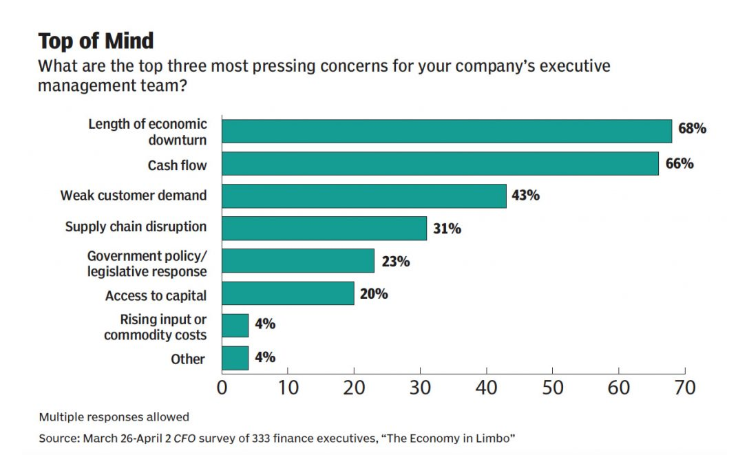This is a guest blog post from our partner Workday Adaptive Planning, written by Michael Magaro. The blog post was originally published on FEI Daily.
The COVID-19 pandemic changed our world, almost overnight, and businesses are having to adjust. The unprecedented nature of the pandemic means no one knows how deep the economic downturn will be, or how long it will last, which makes financial planning for businesses especially difficult.
Fitch Ratings’ “Global Economic Outlook” states that global economic activity will decline by 1.9% this year with the U.S., Eurozone and UK GDP down by 3.3%, 4.2% and 3.9%, respectively. Some industries will be more impacted than others, and next to no one has historical experience with pandemic conditions.
Companies are clearly having a hard time planning. A survey from Gartner of 99 CFOs and finance leaders taken April 14-19 revealed that 42% of CFOs have not incorporated a second wave outbreak of COVID-19 in the financial scenarios they are building for the remainder of 2020, a finding dubbed “surprising,” by Alexander Bant, practice vice president, research, for the Gartner Finance. Many public companies have also withdrawn guidance due to lack of visibility.
So how do companies plan when visibility is so cloudy, and unknowns are so numerous?
For the finance team at Workday, we are embracing scenario planning—basically harnessing the power of “what if”—to respond to COVID-19, and so are many of our customers. Our cloud planning platform is processing up to 30 times more forecasts and build-out scenarios for customers than in a typical, pre-pandemic week. And given the volatility and unpredictability we’ve seen, it’s not likely to ease up soon.
But the reality is that agility starts with planning. Not long before the pandemic hit, we, like many companies, had our plan in hand and were evaluating many different potential outcomes, including whether the long-running economic expansion would begin to show signs of slowing. As the realities of the pandemic came into view, we stepped up scenario planning in order to adapt to changing market conditions–and achieve the level of agility our business demands. And, while we continue to adjust and adapt like all companies, we identified five critical steps for successful scenario planning.
Step One: Assess potential impact to the top line
How will what’s happening impact revenue and the various revenue streams that feed the top line number? For many companies, this will include impacts to new business activity, customer retention, and assumptions that went into the impact of new product launches — if any exist.
Each business faces a different situation. During the pandemic, many hospitality businesses are struggling. Meanwhile, many online retailers are going strong. Each industry’s history can be instructive. During the 2002 Dotcom crash and the 2008 financial crisis, for instance, software companies with a higher percentage of SMB customers took a bigger hit to monthly renewal rates.
Because no one has historical data for a pandemic, it’s important to start off fairly basic with scenario planning. Model some elements from the top line, such as new sales, business renewal activity, and up-sell to existing customers by quarter throughout the year. Consider a range of scenarios possible for your business, perhaps 50%, 65% and 80% of a pre-pandemic plan. This gives a good view into what could happen to the income statement and balance sheet and help businesses understand variances on metrics that matter most to them. For organizations similar to Workday, that’s subscription revenue growth, non-GAAP operating margin, and, ultimately, cash flow.
Step Two: Identify levers on the investment side of the business
What levers do you have to pull? For most companies, people are the biggest cost. Do you hire as planned before the pandemic? What are the differences between hiring as planned, freezing hiring for the rest of the year, and the range of options in between? No business wants to cut job cuts at any time, so it’s important to understand other cost levers at your disposal, and the various outcomes possible when you pull them. To understand your big levers, you have to really understand your business.
Step Three: Align leadership
The finance team alone should not decide steps one and two. Involve all leaders so you get the right picture and analysis, and make sure you’ve identified the right levers. Involving leaders keeps everyone aligned and thinking about the right things. For many companies this may take the form of dashboards shared across the leadership team or creating regular review meetings.
Step Four: Identify a good outcome
Ask what a good outcome looks like for your organization. This will differ for each organization. Is it to retain existing customers? Is it to retain your workforce, or to maintain a customer satisfaction standard? Is it to expand and win market share from distracted competitors? By identifying what matters most to your organization, you’ll better prioritize through steps one, two, and three. And in today’s climate, that desired outcome may change, further elevating the importance of a continuous approach to planning.
Step Five: Dive deeper
Once you have your various scenarios, and have received feedback on them, dive deeper. For some companies, this will mean digging into supply chain issues, for others it may be assessing risk by segment, etc. Third-party research can help you decide how to respond. For instance, if you know a number of your suppliers or customers are feeling a lot of pain, how can you be proactive in supporting them? Align various teams on this topic, too. For instance, sales and customer service hear directly from customers. Their knowledge should inform your analysis and drive your ability to help your customers, partners, and your own top line.
Scenario planning to continuous planning
Even prior to the pandemic, Workday’s finance organization was working toward a continuous planning framework. Our aim is to shift from annual planning and budgeting to continuous planning via more frequent reviews and assessment of how changing conditions impact our product roadmaps, and vice-a-versa. Along the way, we look at such things as margins and cash flow. Whenever conditions change, we anticipate being able to take action and adjust our model. For instance, if product development runs behind schedule, do we adjust by upping investment to get it back up to speed or do we adjust our top line estimates? If we’re operating correctly under the continuous planning framework, planning is not a point in time—it is continuous.
Embracing flexibility
The pandemic is challenging us as humans, as companies, and as business partners in all kinds of new ways. When any crisis hits, finance teams need to be able to seamlessly navigate the kinks that come with uncertainty. Scenario planning—and eventually continuous planning—enables us to embrace flexibility and to use it our advantage.
This blog post was also published by Workday Adaptive Planning and appeared here.




